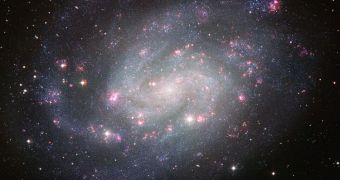Following an observations campaign that lasted several years, astronomers at ESO finally managed to produce the most accurate and detailed image of the superb spiral galaxy NGC 300.
The formation is located relatively close by, in the Sculptor Group of galaxies, and it is widely considered to be one of the most easy-to-observe structures in the Southern Hemisphere.
The recent image was pieced together from a multitude of different observations, taken over a period of a few years, by experts using numerous color filters.
In total, it took about 50 hours of exposure time to collect the data necessary to create this view. The Wide Field Imager (WFI) at the ESO La Silla Observatory, in Chile, was the main instrument used for the job.
The European Southern Observatory has numerous facilities in Chile, a country that houses parts of the Atacama Desert. This is the most arid desert on the face of the planet, and also one of the driest.
Precipitations here are scarce, and clouds are almost unheard of, and this sets the perfect stage for astronomical observations.
This allowed the WFI to observe NGC 300 in exquisite detail, experts say. Other galaxies in the Sculptor Group that have been imaged using ESO telescopes include NGC 55, NGC 253, and NGC 7793.
Generally, the Group inconspicuous, but it is actually the home of numerous interesting galaxies. NGC 300 is no exception in this regard.
In fact, the thing that makes this galaxy is interesting is not some extreme characteristic, but rather the fact that it's perfectly normal.
Given its similarities to our own Milky Way, experts are analyzing it as a means of deriving more data on our home galaxy as well. We can't get out of the Milky Way yet, but we can observe it from a distance.
“The data was acquired over many observing nights, spanning several years,” the ESO experts say.
“The main purpose of this extensive observational campaign was to take an unusually thorough census of the stars in the galaxy, counting both the number and varieties of the stars, and marking regions, or even individual stars, that warrant deeper and more focused investigation,” they add.
“By observing the galaxy with filters that isolate the light coming specifically from hydrogen and oxygen, the many star-forming regions along NGC 300’s spiral arms are shown with particular clarity in this image as red and pink clouds,” the ESO team concludes.

 14 DAY TRIAL //
14 DAY TRIAL //